Legal Research and Writing Assignment
VerifiedAdded on 2023/06/04
|13
|2984
|485
AI Summary
This article discusses the court system in Singapore and the primary and secondary sources of law. It highlights the areas of focus of the Supreme Court and the State Court and their relevant law and procedures. The article also explains the work process and application of primary and secondary sources of law in Singapore.
Contribute Materials
Your contribution can guide someone’s learning journey. Share your
documents today.
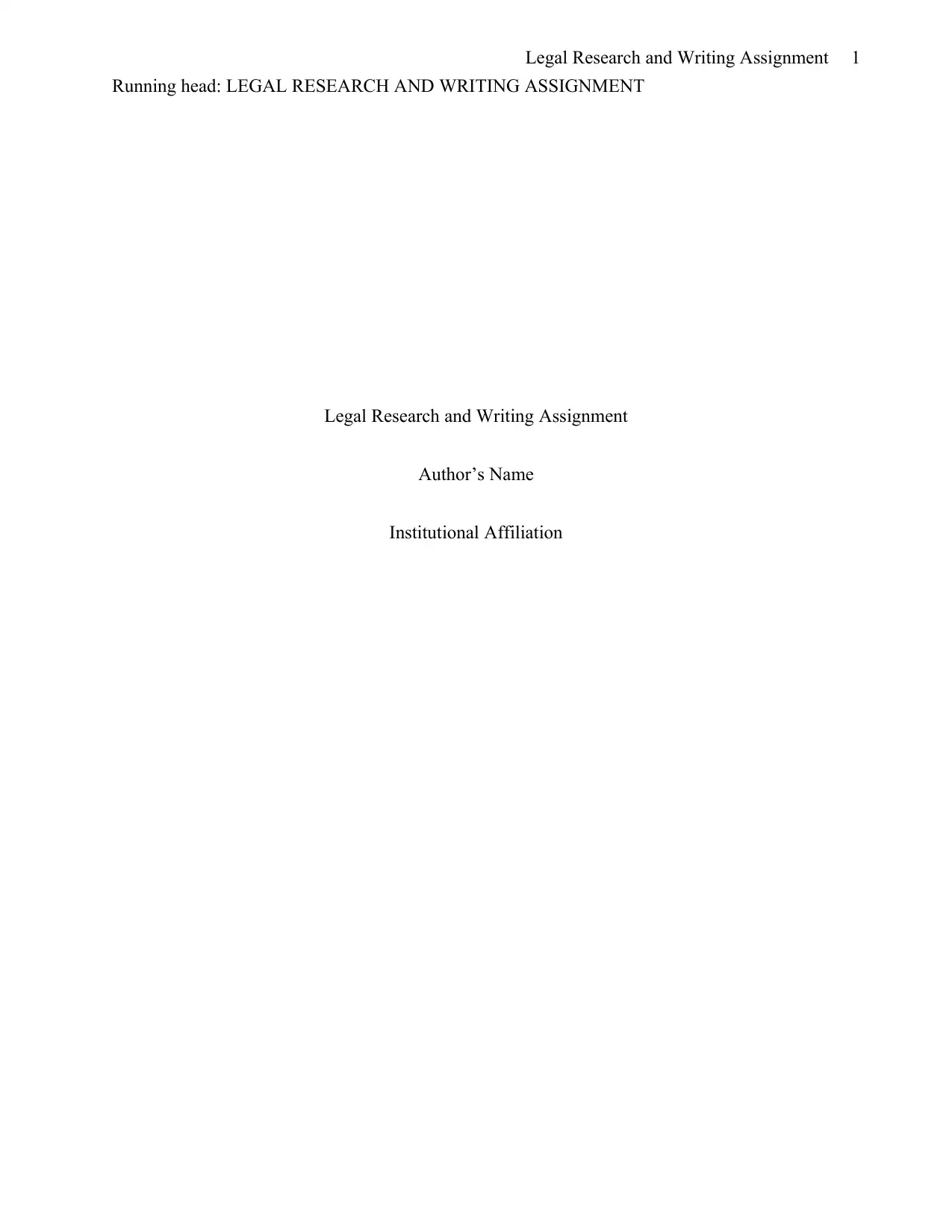
1Legal Research and Writing Assignment
Running head: LEGAL RESEARCH AND WRITING ASSIGNMENT
Legal Research and Writing Assignment
Author’s Name
Institutional Affiliation
Running head: LEGAL RESEARCH AND WRITING ASSIGNMENT
Legal Research and Writing Assignment
Author’s Name
Institutional Affiliation
Secure Best Marks with AI Grader
Need help grading? Try our AI Grader for instant feedback on your assignments.
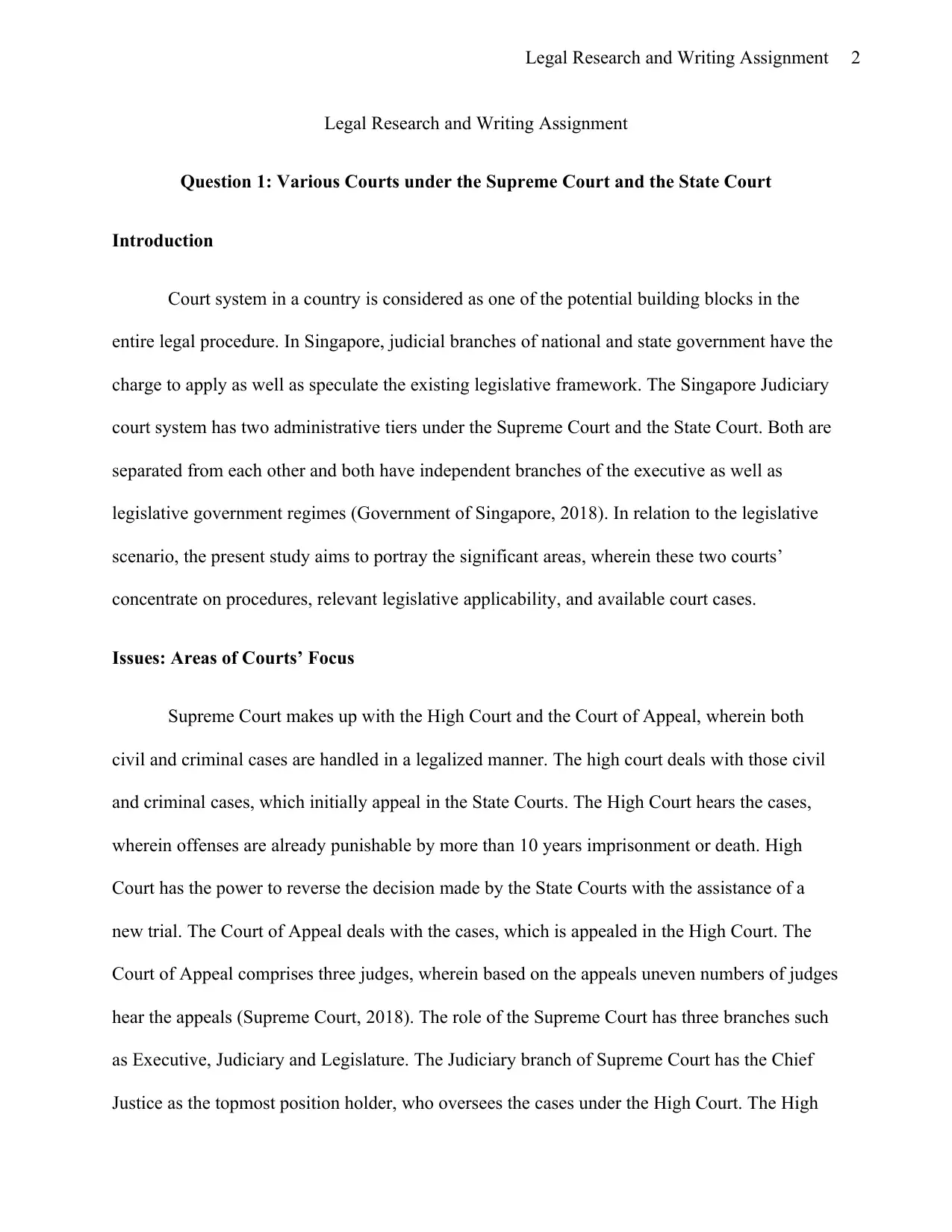
2Legal Research and Writing Assignment
Legal Research and Writing Assignment
Question 1: Various Courts under the Supreme Court and the State Court
Introduction
Court system in a country is considered as one of the potential building blocks in the
entire legal procedure. In Singapore, judicial branches of national and state government have the
charge to apply as well as speculate the existing legislative framework. The Singapore Judiciary
court system has two administrative tiers under the Supreme Court and the State Court. Both are
separated from each other and both have independent branches of the executive as well as
legislative government regimes (Government of Singapore, 2018). In relation to the legislative
scenario, the present study aims to portray the significant areas, wherein these two courts’
concentrate on procedures, relevant legislative applicability, and available court cases.
Issues: Areas of Courts’ Focus
Supreme Court makes up with the High Court and the Court of Appeal, wherein both
civil and criminal cases are handled in a legalized manner. The high court deals with those civil
and criminal cases, which initially appeal in the State Courts. The High Court hears the cases,
wherein offenses are already punishable by more than 10 years imprisonment or death. High
Court has the power to reverse the decision made by the State Courts with the assistance of a
new trial. The Court of Appeal deals with the cases, which is appealed in the High Court. The
Court of Appeal comprises three judges, wherein based on the appeals uneven numbers of judges
hear the appeals (Supreme Court, 2018). The role of the Supreme Court has three branches such
as Executive, Judiciary and Legislature. The Judiciary branch of Supreme Court has the Chief
Justice as the topmost position holder, who oversees the cases under the High Court. The High
Legal Research and Writing Assignment
Question 1: Various Courts under the Supreme Court and the State Court
Introduction
Court system in a country is considered as one of the potential building blocks in the
entire legal procedure. In Singapore, judicial branches of national and state government have the
charge to apply as well as speculate the existing legislative framework. The Singapore Judiciary
court system has two administrative tiers under the Supreme Court and the State Court. Both are
separated from each other and both have independent branches of the executive as well as
legislative government regimes (Government of Singapore, 2018). In relation to the legislative
scenario, the present study aims to portray the significant areas, wherein these two courts’
concentrate on procedures, relevant legislative applicability, and available court cases.
Issues: Areas of Courts’ Focus
Supreme Court makes up with the High Court and the Court of Appeal, wherein both
civil and criminal cases are handled in a legalized manner. The high court deals with those civil
and criminal cases, which initially appeal in the State Courts. The High Court hears the cases,
wherein offenses are already punishable by more than 10 years imprisonment or death. High
Court has the power to reverse the decision made by the State Courts with the assistance of a
new trial. The Court of Appeal deals with the cases, which is appealed in the High Court. The
Court of Appeal comprises three judges, wherein based on the appeals uneven numbers of judges
hear the appeals (Supreme Court, 2018). The role of the Supreme Court has three branches such
as Executive, Judiciary and Legislature. The Judiciary branch of Supreme Court has the Chief
Justice as the topmost position holder, who oversees the cases under the High Court. The High
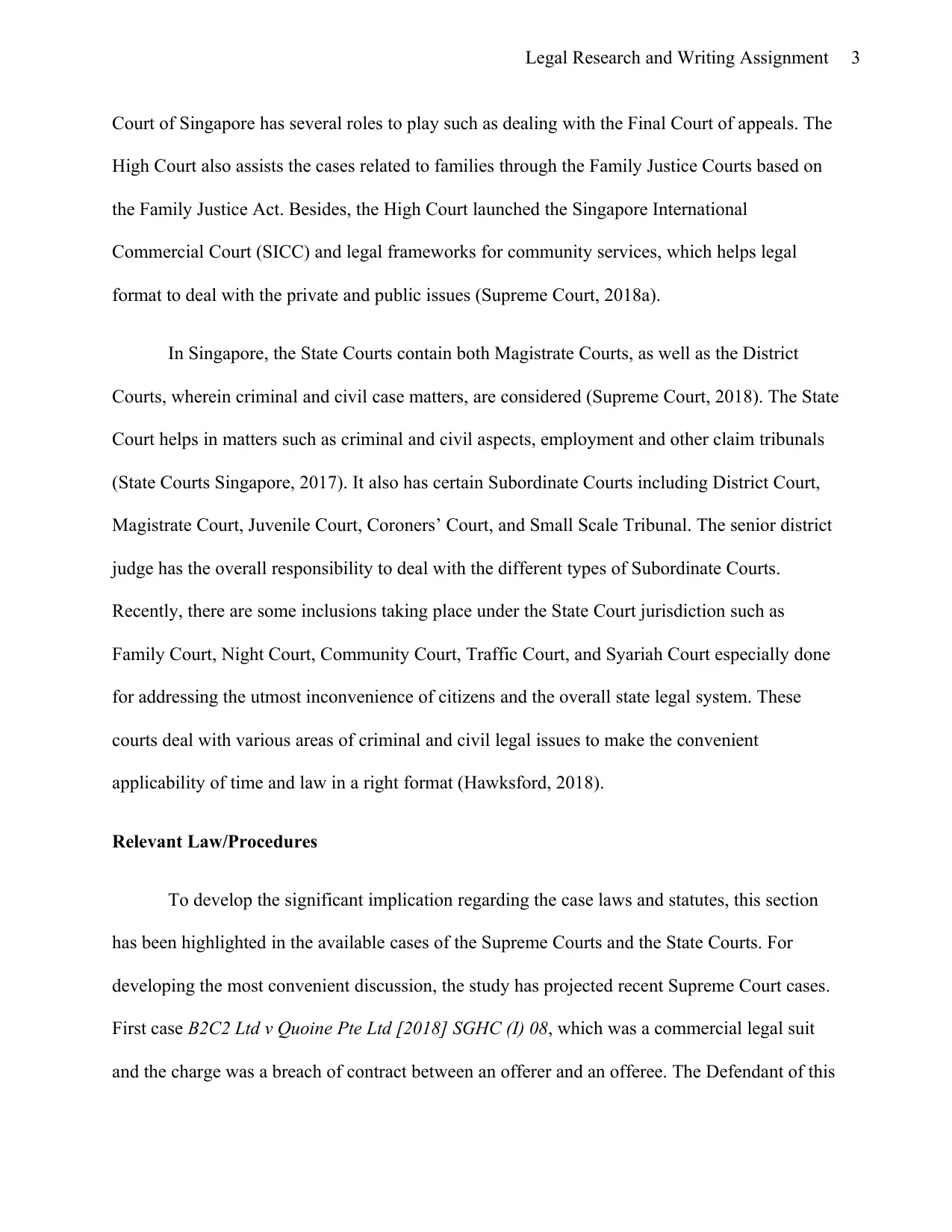
3Legal Research and Writing Assignment
Court of Singapore has several roles to play such as dealing with the Final Court of appeals. The
High Court also assists the cases related to families through the Family Justice Courts based on
the Family Justice Act. Besides, the High Court launched the Singapore International
Commercial Court (SICC) and legal frameworks for community services, which helps legal
format to deal with the private and public issues (Supreme Court, 2018a).
In Singapore, the State Courts contain both Magistrate Courts, as well as the District
Courts, wherein criminal and civil case matters, are considered (Supreme Court, 2018). The State
Court helps in matters such as criminal and civil aspects, employment and other claim tribunals
(State Courts Singapore, 2017). It also has certain Subordinate Courts including District Court,
Magistrate Court, Juvenile Court, Coroners’ Court, and Small Scale Tribunal. The senior district
judge has the overall responsibility to deal with the different types of Subordinate Courts.
Recently, there are some inclusions taking place under the State Court jurisdiction such as
Family Court, Night Court, Community Court, Traffic Court, and Syariah Court especially done
for addressing the utmost inconvenience of citizens and the overall state legal system. These
courts deal with various areas of criminal and civil legal issues to make the convenient
applicability of time and law in a right format (Hawksford, 2018).
Relevant Law/Procedures
To develop the significant implication regarding the case laws and statutes, this section
has been highlighted in the available cases of the Supreme Courts and the State Courts. For
developing the most convenient discussion, the study has projected recent Supreme Court cases.
First case B2C2 Ltd v Quoine Pte Ltd [2018] SGHC (I) 08, which was a commercial legal suit
and the charge was a breach of contract between an offerer and an offeree. The Defendant of this
Court of Singapore has several roles to play such as dealing with the Final Court of appeals. The
High Court also assists the cases related to families through the Family Justice Courts based on
the Family Justice Act. Besides, the High Court launched the Singapore International
Commercial Court (SICC) and legal frameworks for community services, which helps legal
format to deal with the private and public issues (Supreme Court, 2018a).
In Singapore, the State Courts contain both Magistrate Courts, as well as the District
Courts, wherein criminal and civil case matters, are considered (Supreme Court, 2018). The State
Court helps in matters such as criminal and civil aspects, employment and other claim tribunals
(State Courts Singapore, 2017). It also has certain Subordinate Courts including District Court,
Magistrate Court, Juvenile Court, Coroners’ Court, and Small Scale Tribunal. The senior district
judge has the overall responsibility to deal with the different types of Subordinate Courts.
Recently, there are some inclusions taking place under the State Court jurisdiction such as
Family Court, Night Court, Community Court, Traffic Court, and Syariah Court especially done
for addressing the utmost inconvenience of citizens and the overall state legal system. These
courts deal with various areas of criminal and civil legal issues to make the convenient
applicability of time and law in a right format (Hawksford, 2018).
Relevant Law/Procedures
To develop the significant implication regarding the case laws and statutes, this section
has been highlighted in the available cases of the Supreme Courts and the State Courts. For
developing the most convenient discussion, the study has projected recent Supreme Court cases.
First case B2C2 Ltd v Quoine Pte Ltd [2018] SGHC (I) 08, which was a commercial legal suit
and the charge was a breach of contract between an offerer and an offeree. The Defendant of this
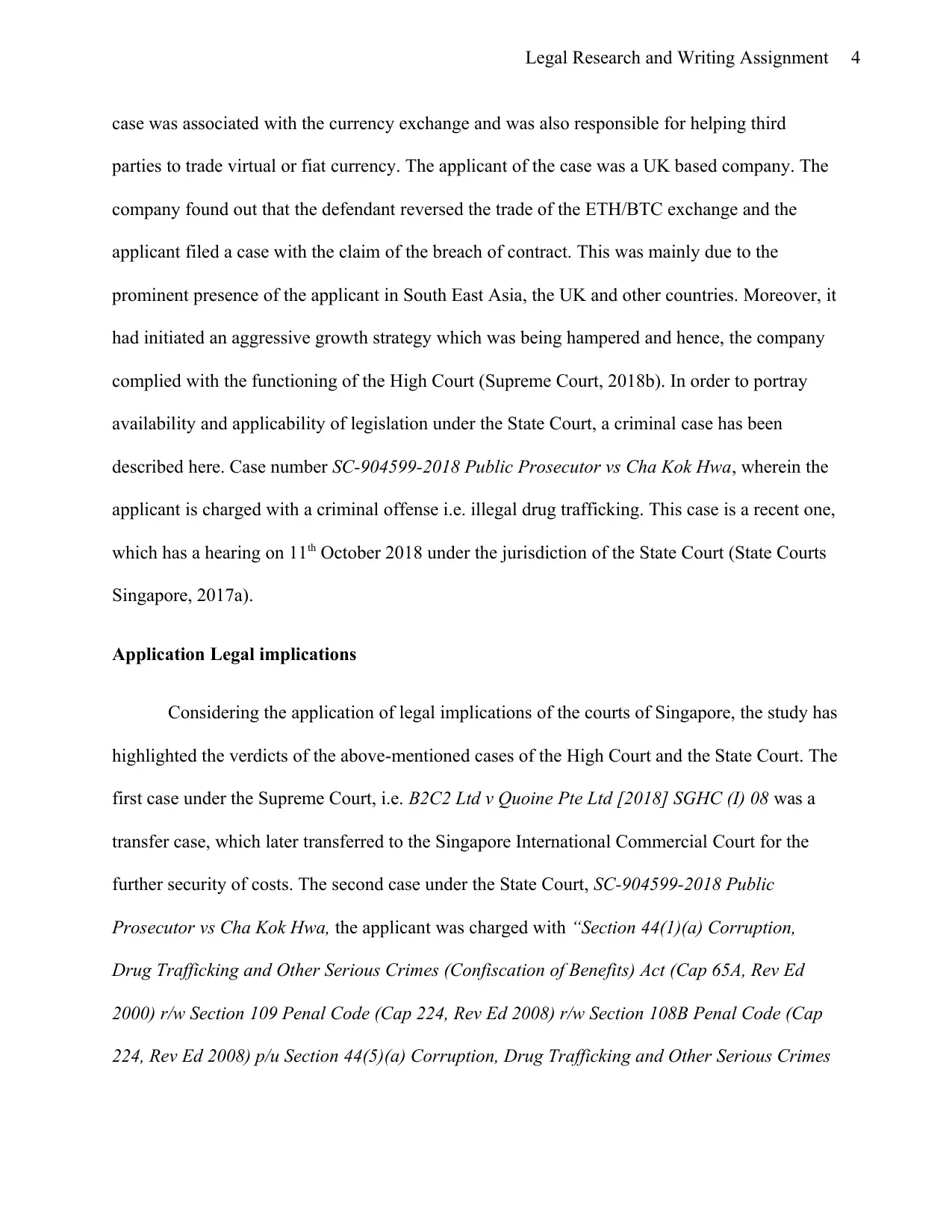
4Legal Research and Writing Assignment
case was associated with the currency exchange and was also responsible for helping third
parties to trade virtual or fiat currency. The applicant of the case was a UK based company. The
company found out that the defendant reversed the trade of the ETH/BTC exchange and the
applicant filed a case with the claim of the breach of contract. This was mainly due to the
prominent presence of the applicant in South East Asia, the UK and other countries. Moreover, it
had initiated an aggressive growth strategy which was being hampered and hence, the company
complied with the functioning of the High Court (Supreme Court, 2018b). In order to portray
availability and applicability of legislation under the State Court, a criminal case has been
described here. Case number SC-904599-2018 Public Prosecutor vs Cha Kok Hwa, wherein the
applicant is charged with a criminal offense i.e. illegal drug trafficking. This case is a recent one,
which has a hearing on 11th October 2018 under the jurisdiction of the State Court (State Courts
Singapore, 2017a).
Application Legal implications
Considering the application of legal implications of the courts of Singapore, the study has
highlighted the verdicts of the above-mentioned cases of the High Court and the State Court. The
first case under the Supreme Court, i.e. B2C2 Ltd v Quoine Pte Ltd [2018] SGHC (I) 08 was a
transfer case, which later transferred to the Singapore International Commercial Court for the
further security of costs. The second case under the State Court, SC-904599-2018 Public
Prosecutor vs Cha Kok Hwa, the applicant was charged with “Section 44(1)(a) Corruption,
Drug Trafficking and Other Serious Crimes (Confiscation of Benefits) Act (Cap 65A, Rev Ed
2000) r/w Section 109 Penal Code (Cap 224, Rev Ed 2008) r/w Section 108B Penal Code (Cap
224, Rev Ed 2008) p/u Section 44(5)(a) Corruption, Drug Trafficking and Other Serious Crimes
case was associated with the currency exchange and was also responsible for helping third
parties to trade virtual or fiat currency. The applicant of the case was a UK based company. The
company found out that the defendant reversed the trade of the ETH/BTC exchange and the
applicant filed a case with the claim of the breach of contract. This was mainly due to the
prominent presence of the applicant in South East Asia, the UK and other countries. Moreover, it
had initiated an aggressive growth strategy which was being hampered and hence, the company
complied with the functioning of the High Court (Supreme Court, 2018b). In order to portray
availability and applicability of legislation under the State Court, a criminal case has been
described here. Case number SC-904599-2018 Public Prosecutor vs Cha Kok Hwa, wherein the
applicant is charged with a criminal offense i.e. illegal drug trafficking. This case is a recent one,
which has a hearing on 11th October 2018 under the jurisdiction of the State Court (State Courts
Singapore, 2017a).
Application Legal implications
Considering the application of legal implications of the courts of Singapore, the study has
highlighted the verdicts of the above-mentioned cases of the High Court and the State Court. The
first case under the Supreme Court, i.e. B2C2 Ltd v Quoine Pte Ltd [2018] SGHC (I) 08 was a
transfer case, which later transferred to the Singapore International Commercial Court for the
further security of costs. The second case under the State Court, SC-904599-2018 Public
Prosecutor vs Cha Kok Hwa, the applicant was charged with “Section 44(1)(a) Corruption,
Drug Trafficking and Other Serious Crimes (Confiscation of Benefits) Act (Cap 65A, Rev Ed
2000) r/w Section 109 Penal Code (Cap 224, Rev Ed 2008) r/w Section 108B Penal Code (Cap
224, Rev Ed 2008) p/u Section 44(5)(a) Corruption, Drug Trafficking and Other Serious Crimes
Secure Best Marks with AI Grader
Need help grading? Try our AI Grader for instant feedback on your assignments.
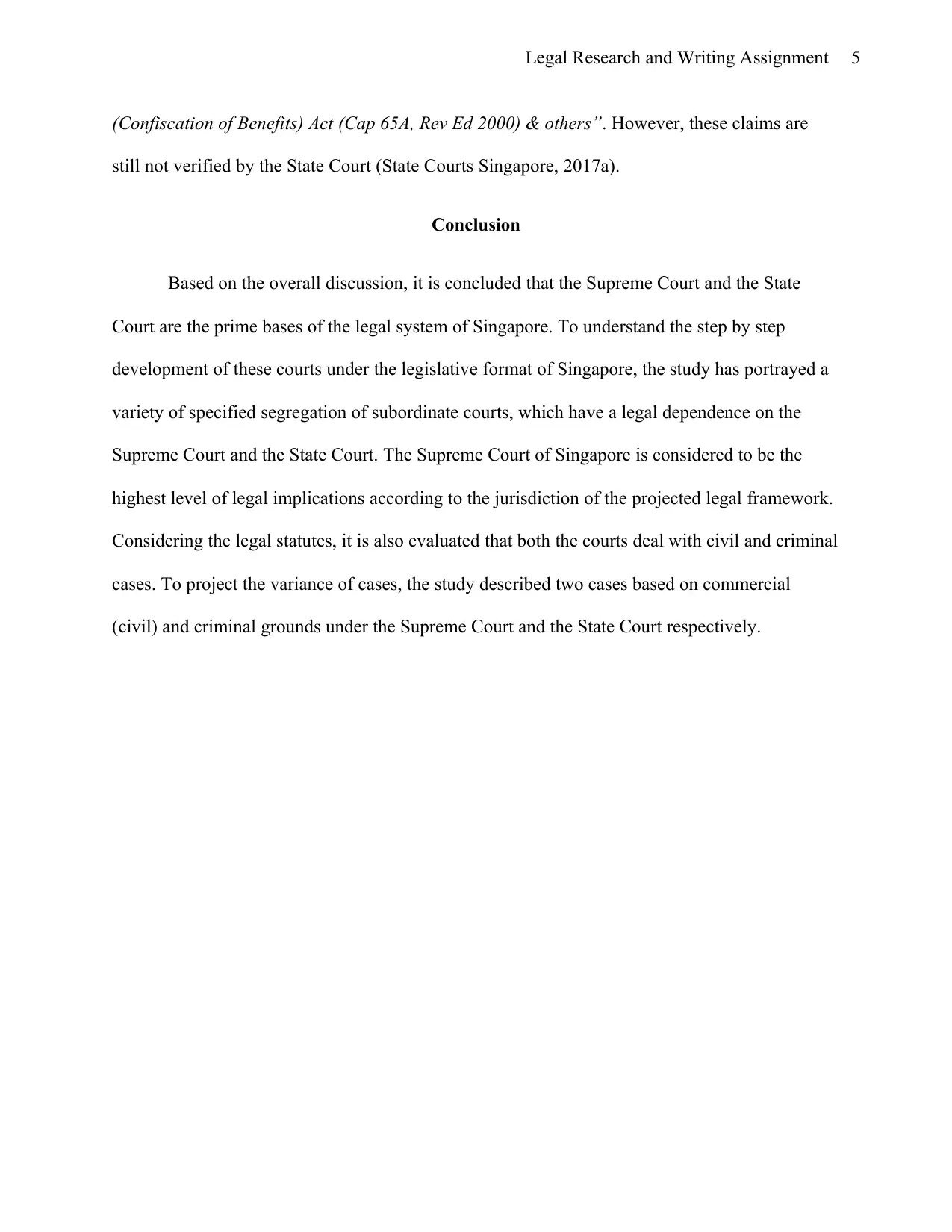
5Legal Research and Writing Assignment
(Confiscation of Benefits) Act (Cap 65A, Rev Ed 2000) & others”. However, these claims are
still not verified by the State Court (State Courts Singapore, 2017a).
Conclusion
Based on the overall discussion, it is concluded that the Supreme Court and the State
Court are the prime bases of the legal system of Singapore. To understand the step by step
development of these courts under the legislative format of Singapore, the study has portrayed a
variety of specified segregation of subordinate courts, which have a legal dependence on the
Supreme Court and the State Court. The Supreme Court of Singapore is considered to be the
highest level of legal implications according to the jurisdiction of the projected legal framework.
Considering the legal statutes, it is also evaluated that both the courts deal with civil and criminal
cases. To project the variance of cases, the study described two cases based on commercial
(civil) and criminal grounds under the Supreme Court and the State Court respectively.
(Confiscation of Benefits) Act (Cap 65A, Rev Ed 2000) & others”. However, these claims are
still not verified by the State Court (State Courts Singapore, 2017a).
Conclusion
Based on the overall discussion, it is concluded that the Supreme Court and the State
Court are the prime bases of the legal system of Singapore. To understand the step by step
development of these courts under the legislative format of Singapore, the study has portrayed a
variety of specified segregation of subordinate courts, which have a legal dependence on the
Supreme Court and the State Court. The Supreme Court of Singapore is considered to be the
highest level of legal implications according to the jurisdiction of the projected legal framework.
Considering the legal statutes, it is also evaluated that both the courts deal with civil and criminal
cases. To project the variance of cases, the study described two cases based on commercial
(civil) and criminal grounds under the Supreme Court and the State Court respectively.
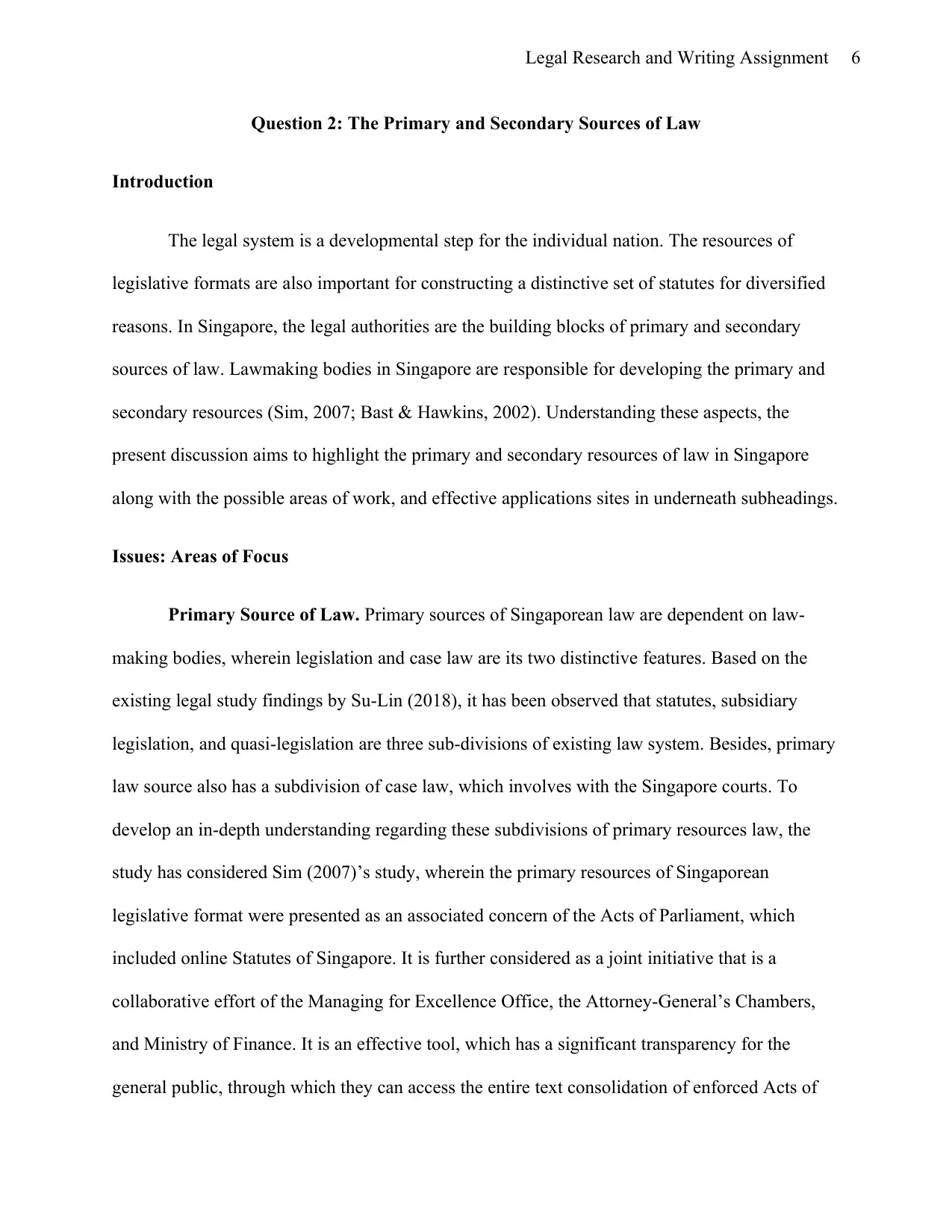
6Legal Research and Writing Assignment
Question 2: The Primary and Secondary Sources of Law
Introduction
The legal system is a developmental step for the individual nation. The resources of
legislative formats are also important for constructing a distinctive set of statutes for diversified
reasons. In Singapore, the legal authorities are the building blocks of primary and secondary
sources of law. Lawmaking bodies in Singapore are responsible for developing the primary and
secondary resources (Sim, 2007; Bast & Hawkins, 2002). Understanding these aspects, the
present discussion aims to highlight the primary and secondary resources of law in Singapore
along with the possible areas of work, and effective applications sites in underneath subheadings.
Issues: Areas of Focus
Primary Source of Law. Primary sources of Singaporean law are dependent on law-
making bodies, wherein legislation and case law are its two distinctive features. Based on the
existing legal study findings by Su-Lin (2018), it has been observed that statutes, subsidiary
legislation, and quasi-legislation are three sub-divisions of existing law system. Besides, primary
law source also has a subdivision of case law, which involves with the Singapore courts. To
develop an in-depth understanding regarding these subdivisions of primary resources law, the
study has considered Sim (2007)’s study, wherein the primary resources of Singaporean
legislative format were presented as an associated concern of the Acts of Parliament, which
included online Statutes of Singapore. It is further considered as a joint initiative that is a
collaborative effort of the Managing for Excellence Office, the Attorney-General’s Chambers,
and Ministry of Finance. It is an effective tool, which has a significant transparency for the
general public, through which they can access the entire text consolidation of enforced Acts of
Question 2: The Primary and Secondary Sources of Law
Introduction
The legal system is a developmental step for the individual nation. The resources of
legislative formats are also important for constructing a distinctive set of statutes for diversified
reasons. In Singapore, the legal authorities are the building blocks of primary and secondary
sources of law. Lawmaking bodies in Singapore are responsible for developing the primary and
secondary resources (Sim, 2007; Bast & Hawkins, 2002). Understanding these aspects, the
present discussion aims to highlight the primary and secondary resources of law in Singapore
along with the possible areas of work, and effective applications sites in underneath subheadings.
Issues: Areas of Focus
Primary Source of Law. Primary sources of Singaporean law are dependent on law-
making bodies, wherein legislation and case law are its two distinctive features. Based on the
existing legal study findings by Su-Lin (2018), it has been observed that statutes, subsidiary
legislation, and quasi-legislation are three sub-divisions of existing law system. Besides, primary
law source also has a subdivision of case law, which involves with the Singapore courts. To
develop an in-depth understanding regarding these subdivisions of primary resources law, the
study has considered Sim (2007)’s study, wherein the primary resources of Singaporean
legislative format were presented as an associated concern of the Acts of Parliament, which
included online Statutes of Singapore. It is further considered as a joint initiative that is a
collaborative effort of the Managing for Excellence Office, the Attorney-General’s Chambers,
and Ministry of Finance. It is an effective tool, which has a significant transparency for the
general public, through which they can access the entire text consolidation of enforced Acts of
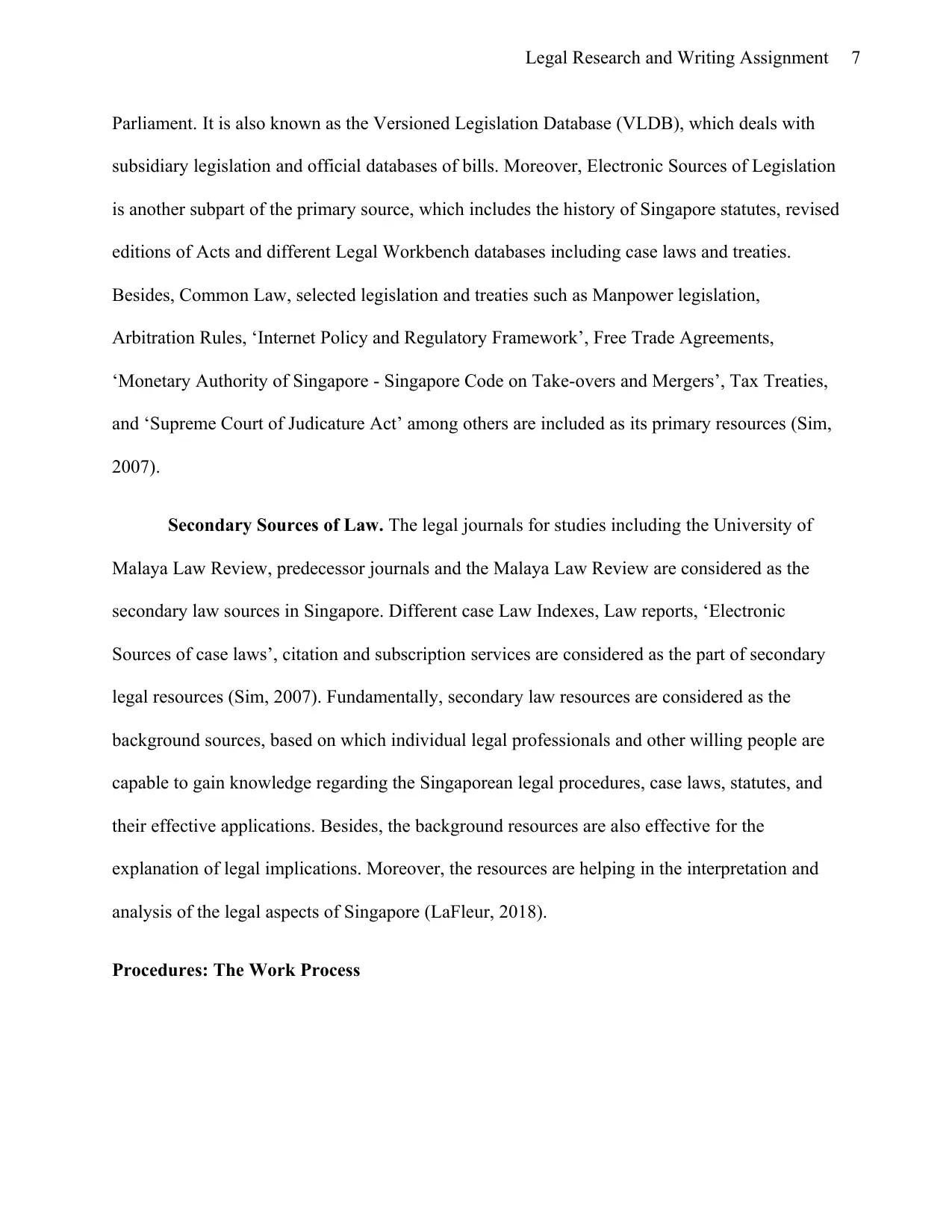
7Legal Research and Writing Assignment
Parliament. It is also known as the Versioned Legislation Database (VLDB), which deals with
subsidiary legislation and official databases of bills. Moreover, Electronic Sources of Legislation
is another subpart of the primary source, which includes the history of Singapore statutes, revised
editions of Acts and different Legal Workbench databases including case laws and treaties.
Besides, Common Law, selected legislation and treaties such as Manpower legislation,
Arbitration Rules, ‘Internet Policy and Regulatory Framework’, Free Trade Agreements,
‘Monetary Authority of Singapore - Singapore Code on Take-overs and Mergers’, Tax Treaties,
and ‘Supreme Court of Judicature Act’ among others are included as its primary resources (Sim,
2007).
Secondary Sources of Law. The legal journals for studies including the University of
Malaya Law Review, predecessor journals and the Malaya Law Review are considered as the
secondary law sources in Singapore. Different case Law Indexes, Law reports, ‘Electronic
Sources of case laws’, citation and subscription services are considered as the part of secondary
legal resources (Sim, 2007). Fundamentally, secondary law resources are considered as the
background sources, based on which individual legal professionals and other willing people are
capable to gain knowledge regarding the Singaporean legal procedures, case laws, statutes, and
their effective applications. Besides, the background resources are also effective for the
explanation of legal implications. Moreover, the resources are helping in the interpretation and
analysis of the legal aspects of Singapore (LaFleur, 2018).
Procedures: The Work Process
Parliament. It is also known as the Versioned Legislation Database (VLDB), which deals with
subsidiary legislation and official databases of bills. Moreover, Electronic Sources of Legislation
is another subpart of the primary source, which includes the history of Singapore statutes, revised
editions of Acts and different Legal Workbench databases including case laws and treaties.
Besides, Common Law, selected legislation and treaties such as Manpower legislation,
Arbitration Rules, ‘Internet Policy and Regulatory Framework’, Free Trade Agreements,
‘Monetary Authority of Singapore - Singapore Code on Take-overs and Mergers’, Tax Treaties,
and ‘Supreme Court of Judicature Act’ among others are included as its primary resources (Sim,
2007).
Secondary Sources of Law. The legal journals for studies including the University of
Malaya Law Review, predecessor journals and the Malaya Law Review are considered as the
secondary law sources in Singapore. Different case Law Indexes, Law reports, ‘Electronic
Sources of case laws’, citation and subscription services are considered as the part of secondary
legal resources (Sim, 2007). Fundamentally, secondary law resources are considered as the
background sources, based on which individual legal professionals and other willing people are
capable to gain knowledge regarding the Singaporean legal procedures, case laws, statutes, and
their effective applications. Besides, the background resources are also effective for the
explanation of legal implications. Moreover, the resources are helping in the interpretation and
analysis of the legal aspects of Singapore (LaFleur, 2018).
Procedures: The Work Process
Paraphrase This Document
Need a fresh take? Get an instant paraphrase of this document with our AI Paraphraser
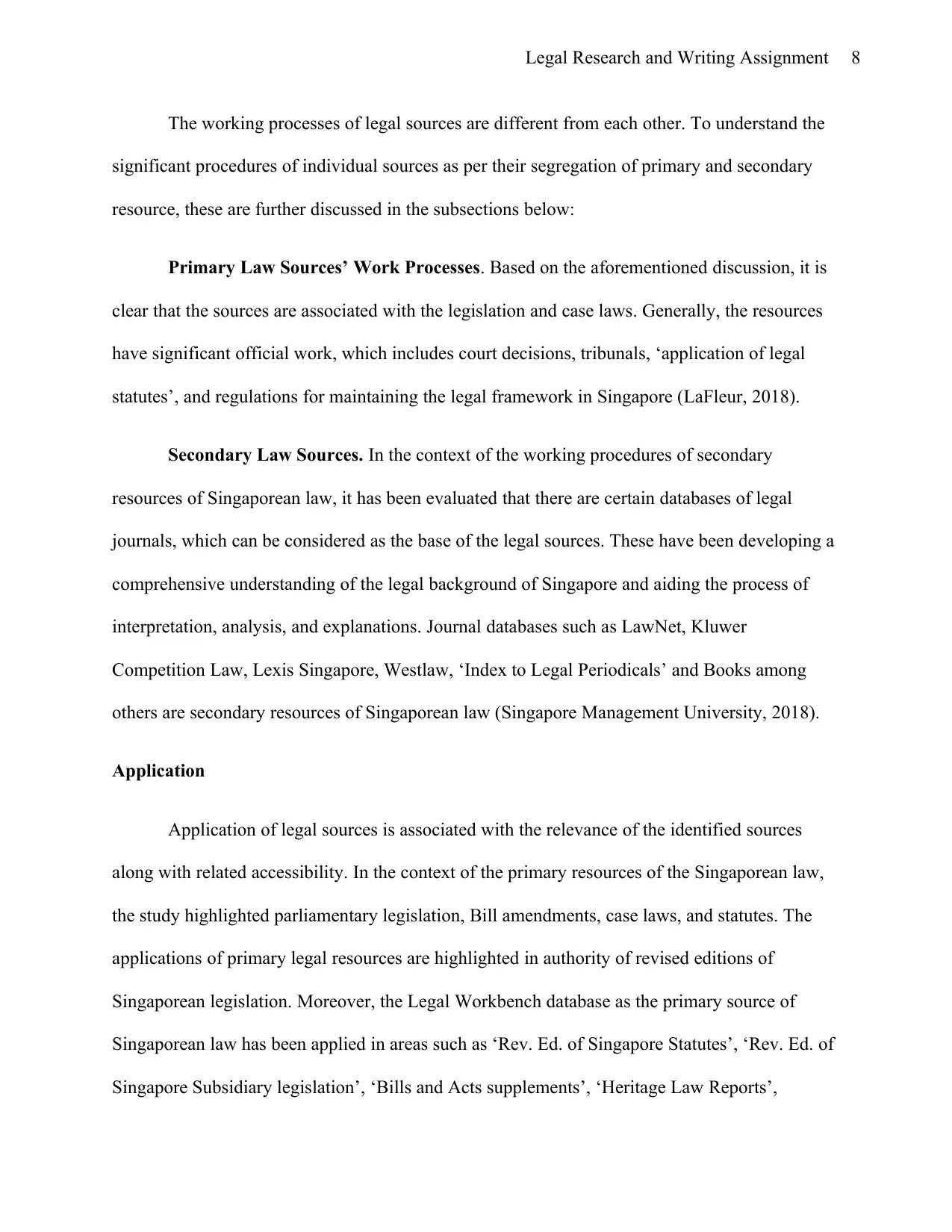
8Legal Research and Writing Assignment
The working processes of legal sources are different from each other. To understand the
significant procedures of individual sources as per their segregation of primary and secondary
resource, these are further discussed in the subsections below:
Primary Law Sources’ Work Processes. Based on the aforementioned discussion, it is
clear that the sources are associated with the legislation and case laws. Generally, the resources
have significant official work, which includes court decisions, tribunals, ‘application of legal
statutes’, and regulations for maintaining the legal framework in Singapore (LaFleur, 2018).
Secondary Law Sources. In the context of the working procedures of secondary
resources of Singaporean law, it has been evaluated that there are certain databases of legal
journals, which can be considered as the base of the legal sources. These have been developing a
comprehensive understanding of the legal background of Singapore and aiding the process of
interpretation, analysis, and explanations. Journal databases such as LawNet, Kluwer
Competition Law, Lexis Singapore, Westlaw, ‘Index to Legal Periodicals’ and Books among
others are secondary resources of Singaporean law (Singapore Management University, 2018).
Application
Application of legal sources is associated with the relevance of the identified sources
along with related accessibility. In the context of the primary resources of the Singaporean law,
the study highlighted parliamentary legislation, Bill amendments, case laws, and statutes. The
applications of primary legal resources are highlighted in authority of revised editions of
Singaporean legislation. Moreover, the Legal Workbench database as the primary source of
Singaporean law has been applied in areas such as ‘Rev. Ed. of Singapore Statutes’, ‘Rev. Ed. of
Singapore Subsidiary legislation’, ‘Bills and Acts supplements’, ‘Heritage Law Reports’,
The working processes of legal sources are different from each other. To understand the
significant procedures of individual sources as per their segregation of primary and secondary
resource, these are further discussed in the subsections below:
Primary Law Sources’ Work Processes. Based on the aforementioned discussion, it is
clear that the sources are associated with the legislation and case laws. Generally, the resources
have significant official work, which includes court decisions, tribunals, ‘application of legal
statutes’, and regulations for maintaining the legal framework in Singapore (LaFleur, 2018).
Secondary Law Sources. In the context of the working procedures of secondary
resources of Singaporean law, it has been evaluated that there are certain databases of legal
journals, which can be considered as the base of the legal sources. These have been developing a
comprehensive understanding of the legal background of Singapore and aiding the process of
interpretation, analysis, and explanations. Journal databases such as LawNet, Kluwer
Competition Law, Lexis Singapore, Westlaw, ‘Index to Legal Periodicals’ and Books among
others are secondary resources of Singaporean law (Singapore Management University, 2018).
Application
Application of legal sources is associated with the relevance of the identified sources
along with related accessibility. In the context of the primary resources of the Singaporean law,
the study highlighted parliamentary legislation, Bill amendments, case laws, and statutes. The
applications of primary legal resources are highlighted in authority of revised editions of
Singaporean legislation. Moreover, the Legal Workbench database as the primary source of
Singaporean law has been applied in areas such as ‘Rev. Ed. of Singapore Statutes’, ‘Rev. Ed. of
Singapore Subsidiary legislation’, ‘Bills and Acts supplements’, ‘Heritage Law Reports’,
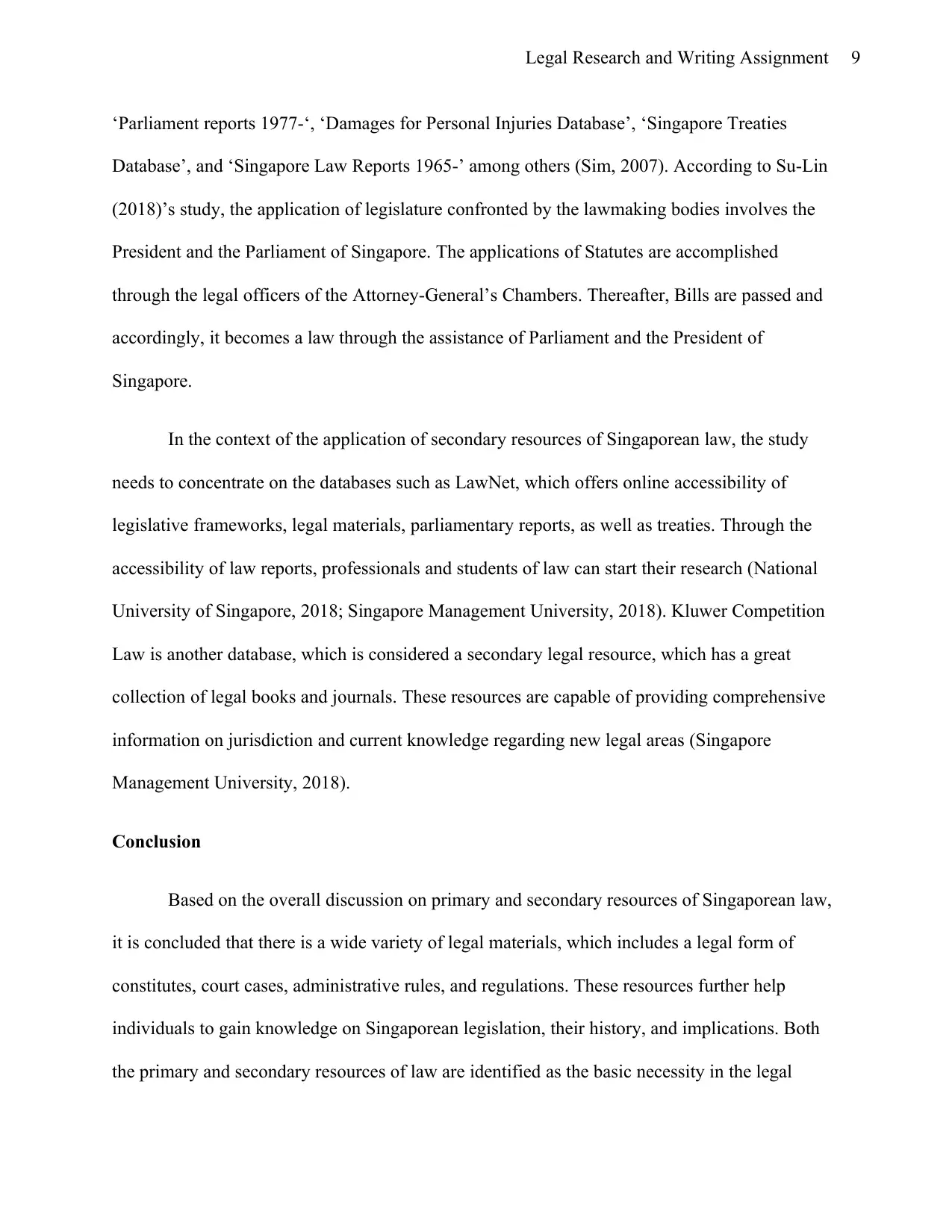
9Legal Research and Writing Assignment
‘Parliament reports 1977-‘, ‘Damages for Personal Injuries Database’, ‘Singapore Treaties
Database’, and ‘Singapore Law Reports 1965-’ among others (Sim, 2007). According to Su-Lin
(2018)’s study, the application of legislature confronted by the lawmaking bodies involves the
President and the Parliament of Singapore. The applications of Statutes are accomplished
through the legal officers of the Attorney-General’s Chambers. Thereafter, Bills are passed and
accordingly, it becomes a law through the assistance of Parliament and the President of
Singapore.
In the context of the application of secondary resources of Singaporean law, the study
needs to concentrate on the databases such as LawNet, which offers online accessibility of
legislative frameworks, legal materials, parliamentary reports, as well as treaties. Through the
accessibility of law reports, professionals and students of law can start their research (National
University of Singapore, 2018; Singapore Management University, 2018). Kluwer Competition
Law is another database, which is considered a secondary legal resource, which has a great
collection of legal books and journals. These resources are capable of providing comprehensive
information on jurisdiction and current knowledge regarding new legal areas (Singapore
Management University, 2018).
Conclusion
Based on the overall discussion on primary and secondary resources of Singaporean law,
it is concluded that there is a wide variety of legal materials, which includes a legal form of
constitutes, court cases, administrative rules, and regulations. These resources further help
individuals to gain knowledge on Singaporean legislation, their history, and implications. Both
the primary and secondary resources of law are identified as the basic necessity in the legal
‘Parliament reports 1977-‘, ‘Damages for Personal Injuries Database’, ‘Singapore Treaties
Database’, and ‘Singapore Law Reports 1965-’ among others (Sim, 2007). According to Su-Lin
(2018)’s study, the application of legislature confronted by the lawmaking bodies involves the
President and the Parliament of Singapore. The applications of Statutes are accomplished
through the legal officers of the Attorney-General’s Chambers. Thereafter, Bills are passed and
accordingly, it becomes a law through the assistance of Parliament and the President of
Singapore.
In the context of the application of secondary resources of Singaporean law, the study
needs to concentrate on the databases such as LawNet, which offers online accessibility of
legislative frameworks, legal materials, parliamentary reports, as well as treaties. Through the
accessibility of law reports, professionals and students of law can start their research (National
University of Singapore, 2018; Singapore Management University, 2018). Kluwer Competition
Law is another database, which is considered a secondary legal resource, which has a great
collection of legal books and journals. These resources are capable of providing comprehensive
information on jurisdiction and current knowledge regarding new legal areas (Singapore
Management University, 2018).
Conclusion
Based on the overall discussion on primary and secondary resources of Singaporean law,
it is concluded that there is a wide variety of legal materials, which includes a legal form of
constitutes, court cases, administrative rules, and regulations. These resources further help
individuals to gain knowledge on Singaporean legislation, their history, and implications. Both
the primary and secondary resources of law are identified as the basic necessity in the legal
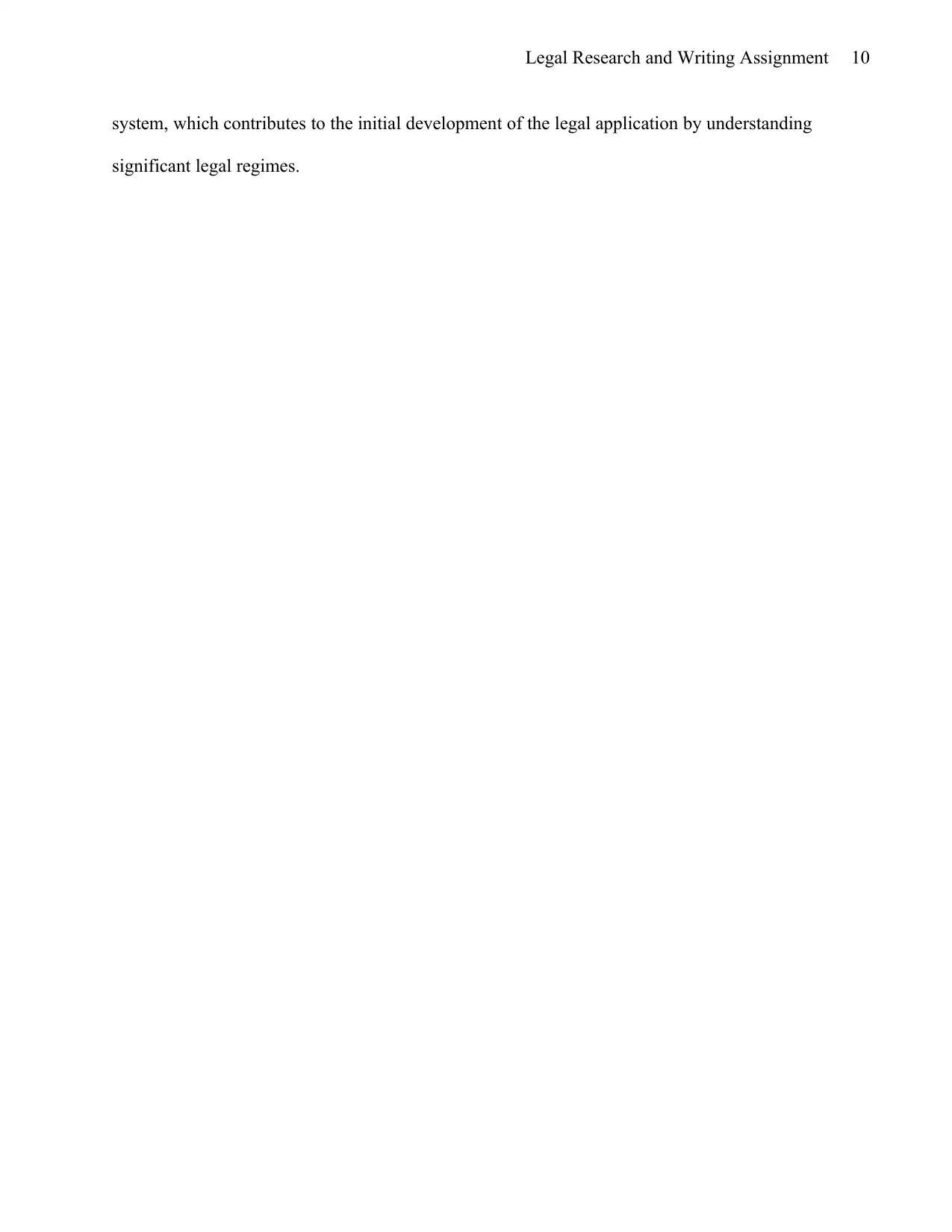
10Legal Research and Writing Assignment
system, which contributes to the initial development of the legal application by understanding
significant legal regimes.
system, which contributes to the initial development of the legal application by understanding
significant legal regimes.
Secure Best Marks with AI Grader
Need help grading? Try our AI Grader for instant feedback on your assignments.
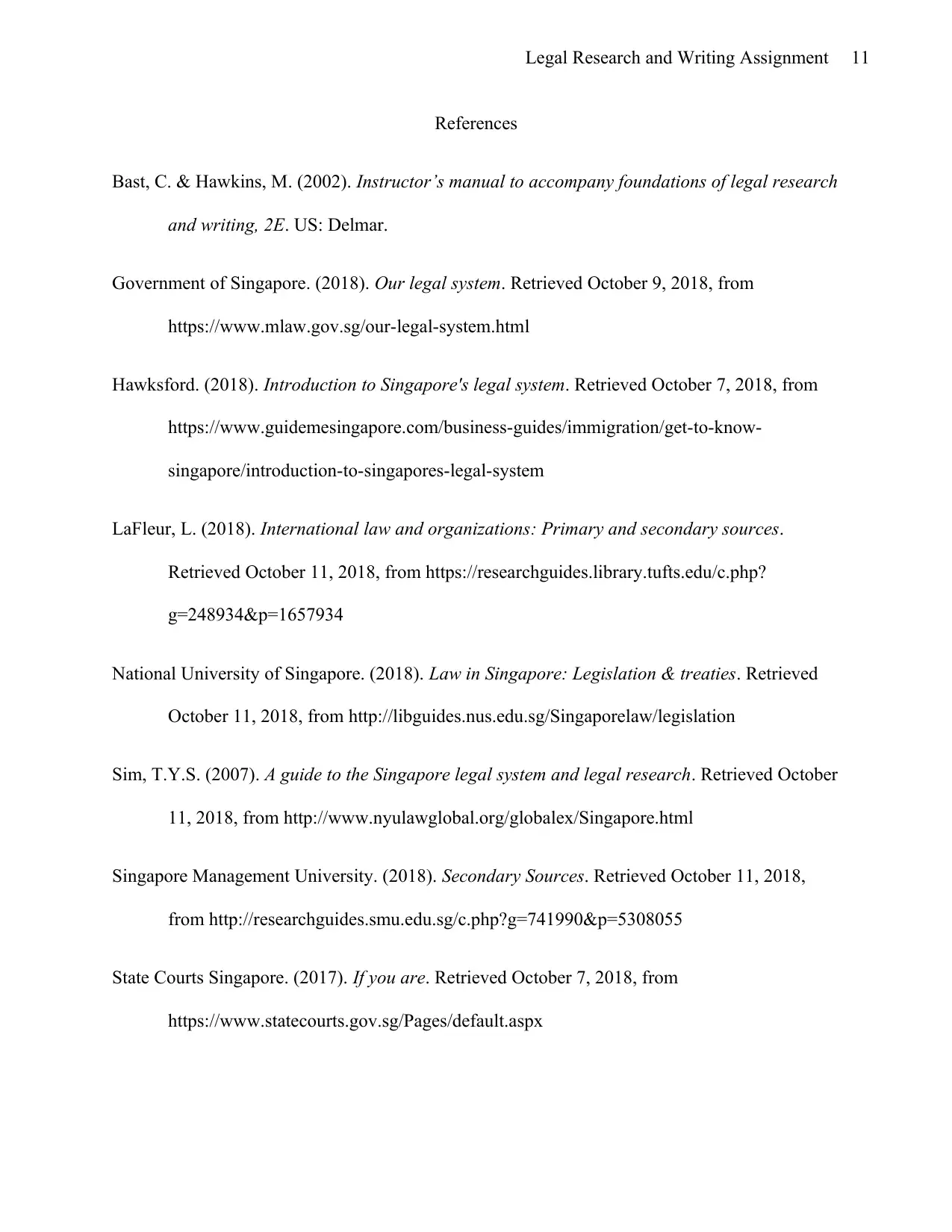
11Legal Research and Writing Assignment
References
Bast, C. & Hawkins, M. (2002). Instructor’s manual to accompany foundations of legal research
and writing, 2E. US: Delmar.
Government of Singapore. (2018). Our legal system. Retrieved October 9, 2018, from
https://www.mlaw.gov.sg/our-legal-system.html
Hawksford. (2018). Introduction to Singapore's legal system. Retrieved October 7, 2018, from
https://www.guidemesingapore.com/business-guides/immigration/get-to-know-
singapore/introduction-to-singapores-legal-system
LaFleur, L. (2018). International law and organizations: Primary and secondary sources.
Retrieved October 11, 2018, from https://researchguides.library.tufts.edu/c.php?
g=248934&p=1657934
National University of Singapore. (2018). Law in Singapore: Legislation & treaties. Retrieved
October 11, 2018, from http://libguides.nus.edu.sg/Singaporelaw/legislation
Sim, T.Y.S. (2007). A guide to the Singapore legal system and legal research. Retrieved October
11, 2018, from http://www.nyulawglobal.org/globalex/Singapore.html
Singapore Management University. (2018). Secondary Sources. Retrieved October 11, 2018,
from http://researchguides.smu.edu.sg/c.php?g=741990&p=5308055
State Courts Singapore. (2017). If you are. Retrieved October 7, 2018, from
https://www.statecourts.gov.sg/Pages/default.aspx
References
Bast, C. & Hawkins, M. (2002). Instructor’s manual to accompany foundations of legal research
and writing, 2E. US: Delmar.
Government of Singapore. (2018). Our legal system. Retrieved October 9, 2018, from
https://www.mlaw.gov.sg/our-legal-system.html
Hawksford. (2018). Introduction to Singapore's legal system. Retrieved October 7, 2018, from
https://www.guidemesingapore.com/business-guides/immigration/get-to-know-
singapore/introduction-to-singapores-legal-system
LaFleur, L. (2018). International law and organizations: Primary and secondary sources.
Retrieved October 11, 2018, from https://researchguides.library.tufts.edu/c.php?
g=248934&p=1657934
National University of Singapore. (2018). Law in Singapore: Legislation & treaties. Retrieved
October 11, 2018, from http://libguides.nus.edu.sg/Singaporelaw/legislation
Sim, T.Y.S. (2007). A guide to the Singapore legal system and legal research. Retrieved October
11, 2018, from http://www.nyulawglobal.org/globalex/Singapore.html
Singapore Management University. (2018). Secondary Sources. Retrieved October 11, 2018,
from http://researchguides.smu.edu.sg/c.php?g=741990&p=5308055
State Courts Singapore. (2017). If you are. Retrieved October 7, 2018, from
https://www.statecourts.gov.sg/Pages/default.aspx
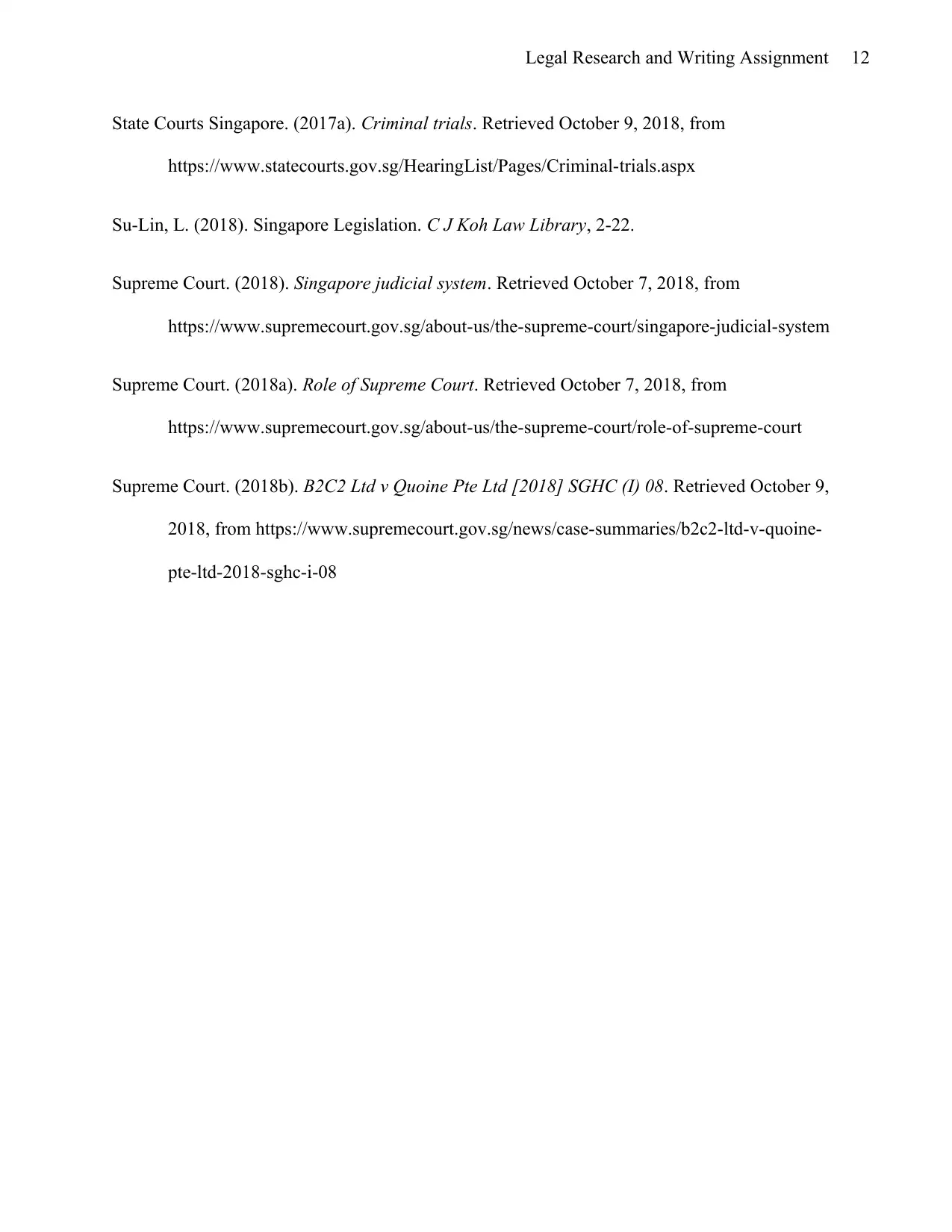
12Legal Research and Writing Assignment
State Courts Singapore. (2017a). Criminal trials. Retrieved October 9, 2018, from
https://www.statecourts.gov.sg/HearingList/Pages/Criminal-trials.aspx
Su-Lin, L. (2018). Singapore Legislation. C J Koh Law Library, 2-22.
Supreme Court. (2018). Singapore judicial system. Retrieved October 7, 2018, from
https://www.supremecourt.gov.sg/about-us/the-supreme-court/singapore-judicial-system
Supreme Court. (2018a). Role of Supreme Court. Retrieved October 7, 2018, from
https://www.supremecourt.gov.sg/about-us/the-supreme-court/role-of-supreme-court
Supreme Court. (2018b). B2C2 Ltd v Quoine Pte Ltd [2018] SGHC (I) 08. Retrieved October 9,
2018, from https://www.supremecourt.gov.sg/news/case-summaries/b2c2-ltd-v-quoine-
pte-ltd-2018-sghc-i-08
State Courts Singapore. (2017a). Criminal trials. Retrieved October 9, 2018, from
https://www.statecourts.gov.sg/HearingList/Pages/Criminal-trials.aspx
Su-Lin, L. (2018). Singapore Legislation. C J Koh Law Library, 2-22.
Supreme Court. (2018). Singapore judicial system. Retrieved October 7, 2018, from
https://www.supremecourt.gov.sg/about-us/the-supreme-court/singapore-judicial-system
Supreme Court. (2018a). Role of Supreme Court. Retrieved October 7, 2018, from
https://www.supremecourt.gov.sg/about-us/the-supreme-court/role-of-supreme-court
Supreme Court. (2018b). B2C2 Ltd v Quoine Pte Ltd [2018] SGHC (I) 08. Retrieved October 9,
2018, from https://www.supremecourt.gov.sg/news/case-summaries/b2c2-ltd-v-quoine-
pte-ltd-2018-sghc-i-08
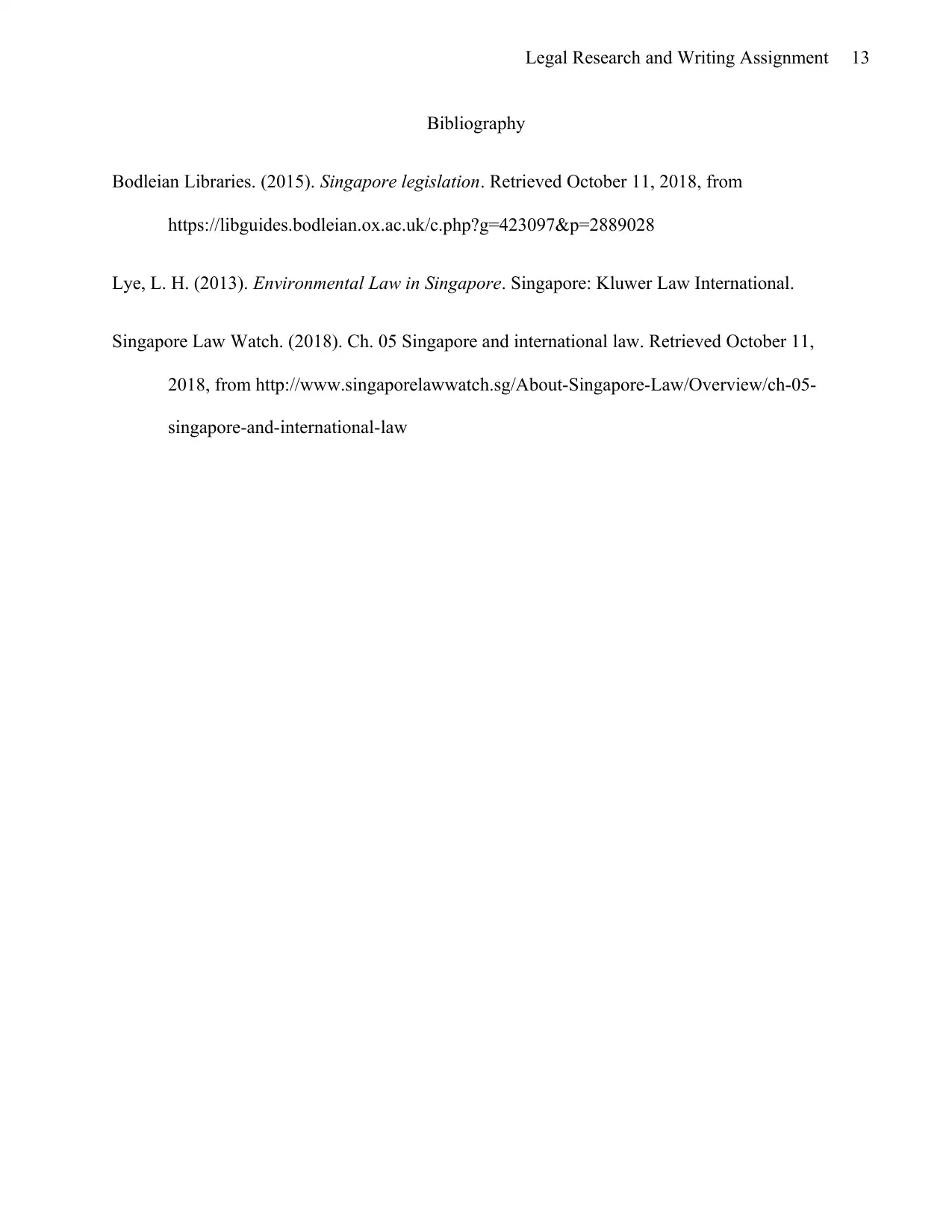
13Legal Research and Writing Assignment
Bibliography
Bodleian Libraries. (2015). Singapore legislation. Retrieved October 11, 2018, from
https://libguides.bodleian.ox.ac.uk/c.php?g=423097&p=2889028
Lye, L. H. (2013). Environmental Law in Singapore. Singapore: Kluwer Law International.
Singapore Law Watch. (2018). Ch. 05 Singapore and international law. Retrieved October 11,
2018, from http://www.singaporelawwatch.sg/About-Singapore-Law/Overview/ch-05-
singapore-and-international-law
Bibliography
Bodleian Libraries. (2015). Singapore legislation. Retrieved October 11, 2018, from
https://libguides.bodleian.ox.ac.uk/c.php?g=423097&p=2889028
Lye, L. H. (2013). Environmental Law in Singapore. Singapore: Kluwer Law International.
Singapore Law Watch. (2018). Ch. 05 Singapore and international law. Retrieved October 11,
2018, from http://www.singaporelawwatch.sg/About-Singapore-Law/Overview/ch-05-
singapore-and-international-law
1 out of 13
Related Documents
Your All-in-One AI-Powered Toolkit for Academic Success.
+13062052269
info@desklib.com
Available 24*7 on WhatsApp / Email
![[object Object]](/_next/static/media/star-bottom.7253800d.svg)
Unlock your academic potential
© 2024 | Zucol Services PVT LTD | All rights reserved.





